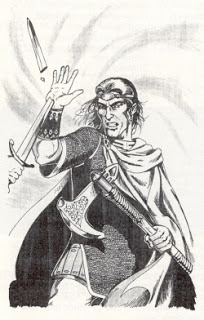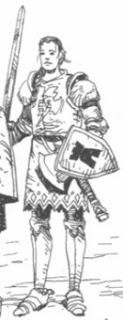 Deities have always held a weird sort of spot in D&D. On the one hand, since the veritable beginning of the game, they were pretty much treated like monsters. The Gods, Demigods, and Heroes supplement for the LBB version of the game basically treats them like more powerful demons. Ares is a 20th level fighter with 250 hp. Tim Kask’s introduction says it’s an attempt to showcase the absurdity of campaigns with 44th level fighters. I daresay it was taken more as a challenge, but the point is the gods depicted way back then were mostly generic. Almost no attention was paid to the worshipers of those gods, and the religion that, at least in theory, supported them.
Deities have always held a weird sort of spot in D&D. On the one hand, since the veritable beginning of the game, they were pretty much treated like monsters. The Gods, Demigods, and Heroes supplement for the LBB version of the game basically treats them like more powerful demons. Ares is a 20th level fighter with 250 hp. Tim Kask’s introduction says it’s an attempt to showcase the absurdity of campaigns with 44th level fighters. I daresay it was taken more as a challenge, but the point is the gods depicted way back then were mostly generic. Almost no attention was paid to the worshipers of those gods, and the religion that, at least in theory, supported them.
 As an example to demonstrate how the conceptions of the deities changed across editions and products, I’m going to follow the clerics of Heironeous. He is the Oeridian deity of chivalry and combat, and is one that always seems to get written up, for what are probably obvious reasons, from a game perspective.
As an example to demonstrate how the conceptions of the deities changed across editions and products, I’m going to follow the clerics of Heironeous. He is the Oeridian deity of chivalry and combat, and is one that always seems to get written up, for what are probably obvious reasons, from a game perspective.AD&D 2nd Edition (Bastion of Faith): Not only are there 15 (!) new spells that go all the way up to 7th level, but there are a bunch of special abilities for specialty clerics of Heironeous (called “Gloryaxes”). At 1st level they get CON bonuses as if they were fighters, get +2 on saves vs. fear, and can cast bless or courage or remove fear once per day; at 3rd level they can cast cloak of bravery or strength once per day; at 5th level they become immune to strength-decreasing magic (a change from before when that came at 6th level); at 7th level they get 3 attacks every 5 rounds; at 9th level they can cast dispel evil or negative plane protection once per day; at 11th level they can cast bolt of glory or power word stun once per day; at 13th level they get 2 attacks per round, and at 20th level they can cast holy word once per day. Whew! This is sort of the mother lode of extra stuff that’s deity-specific, probably going way too far in the direction of detail (one reviewer apparently said it “gives the DM enough details to choke a horse”. And that’s not an incorrect assessment, IMNSHO.
Dungeons & Dragons 3.5 (Player’s Handbook): Clerics have access to the domains of Good, Law, and War. This pulls back a lot of the deity-specific stuff, with more generic spell domains.
Dungeons & Dragons 3.5 (Complete Divine): Shining Blade of Heironeous prestige class for both cleric and paladin. At 1st level they get Shock Blade twice a day (adds 1d6 hp of electrical damage), at 5th level this turns into Holy Blade three times a day (adds 1d6 hp of electrical damage or 2d6 of bonus damage against evil creatures), and at 9th level it becomes Brilliant Blade usable six times per day (like the Holy Blade, but glows and can also pass through nonliving objects, including armor!). There are also two Heironeous-specific magic items (Helm of the Purple Plume and Sword of Virtue Beyond Reproach). Lots more stuff here, not cleric-specific, but might as well be, and the deity-specific magic items are a nice touch, reminiscent of the Hand and Eye of Vecna, or the Wand of Orcus, but not nearly as powerful.
Dungeons & Dragons 3.5 (Dragon Magazine 354): There was a nice lengthy article by Sean Reynolds going into the church of Heironeous. Much of it is background (I loathe the word “fluff” to describe such things), but there are a few things of mechanical interest to clerics; a new spell (Meersalm Skin, a 6th level spell linked to the Meersalm which is a magic item that provides resistance against weapons), it links the Invulnerable Coat of Arnd to Heironeous, and brings in some of the material from Bastion of Faith and 2E (like some of the deity-specific spells).
I’m sure there are other products that give some details about Heironeous’ clerics that I’m missing, but I’m also pretty sure there wasn’t anything in 4E about him (I might very well be wrong – I never got into 4E at all). But I think the above gives the picture. We start to see inklings of deity-specific cleric stuff in 1E, 2E took the ball and ran with it (to the point of excess), 3.5 kept the basic idea but dialed it back, and then started its own expansion of the concept. 4E… I’m not really sure.
And all this brings us to today, where 5th edition doesn’t have anything that is deity-specific in terms of powers, but does present different Divine Domains that function somewhat like the spell spheres of 2nd edition and the domains of 3.5, but in addition to providing 10 spells that don’t need to be prepared (two at each level 1-5, and which can be from outside the normal clerical spell list), there are three unique powers gained at 1st (the Channel Divinity power of turning undead and two others specific to the domain), 2nd, 6th, 8th, and 17th. Each cleric has to choose a domain, and different deities have different domains assigned to them.
Now, here’s where my brilliant idea comes in.
 I posit that, in addition to the “standard” Divine Domains that are shared between clerics of different deities, each god also has a special domain that is unique to it, that clerics could also choose. That domain would follow the same rules as the more generic domains, but would be available only to clerics of that deity.
I posit that, in addition to the “standard” Divine Domains that are shared between clerics of different deities, each god also has a special domain that is unique to it, that clerics could also choose. That domain would follow the same rules as the more generic domains, but would be available only to clerics of that deity.
So, a cleric of Heironeous who chose the special domain of his god would have 10 unique spells (or unique plus other-class spells), and special abilities that come in at levels 1, 2, 6, 8, and 17. Just like any other domain.
TOMORROW – My brilliant idea in action. A 5th Edition Divine Domain specifically for clerics of Heironeous. Part of my Player’s Guide to Greyhawk 576, for 5th edition, I should add…









Excellent stuff, Joe. I look forward to tomorrow's follow-up.
Good look back on editions. I can hardly remember 1e/2e perks for clerics. Deity specific stuff like described for Heironeous has got to be what stands them apart from any other LG cleric.
Heironeous wasn't in 4e as only some of the Greyhawk gods were folded into the new Points of Light setting. With his purview being upheld by Kord and the Forgotten Realm's Bane (Hexor was in the background as a brother Bane murdered to ensure he was the only war god).
However in 4th Edition, Clerics got a class feature called Channel Divinity, with an individual power for the god the character was devoted to. So if a Greyhawk book was ever going to be written, Heironeous would have gotten one.
Maybe a pedantic point, but I'm pretty sure D&DG/L&L had a chart in the back of the book listing miscellaneous stuff regarding priest vestments and holy days, etc. I'm at work so can't check, but I'm sure it's in there.
Ken: Very true, and it does give a (very) little flavor of the religion. But still nothing in terms of cleric game mechanics like we see in the gold box.
Morgan: 5E also has a Channel Divinity power (linked to turn undead at 1st) and something more domain-specific 2nd level. Might be worth looking at the 4E mechanic.
Joseph: agreed!